The asymmetric dynamics of supernovae explosions revealed by a water experiment

Explosions of massive stars known as supernovae are a key process in astrophysics to disseminate the heavy nuclei formed by fusion reactions, while giving birth to compact objects such as neutron stars and black holes.
The supernova fountain reveals in slow motion the asymmetric dynamics of the last second before the explosion when the stellar core collapses to form a proto-neutron star. It demonstrates that sideways explosions are a natural outcome of fluid dynamics. As a consequence, neutron stars are ejected at birth with extreme observed velocities exceeding 1000 km/s and can spin faster than ten times per second.
The astrophysical connection relies on the analogy between water waves in the fountain and acoustic waves in the star. Researchers use this experiment to build their physical intuition about shock instabilities. Its simplicity enables the public to learn about supernovae, the formation of neutron stars and black holes. It has been part of the permanent collection of the Science Museum « Palais de la Découverte » in Paris since 2015.
Why do spherical stars explode highly asymmetrically?
Why do neutron stars speed through interstellar space ten times faster than their massive parent stars?
What is the origin of the rapid rotation of many neutron stars?
How can a simple water fountain experiment provide insight into such astrophysical questions?
Answers to these questions are appended below after a description of stellar death and the fountain setup, illustrated by some videos.
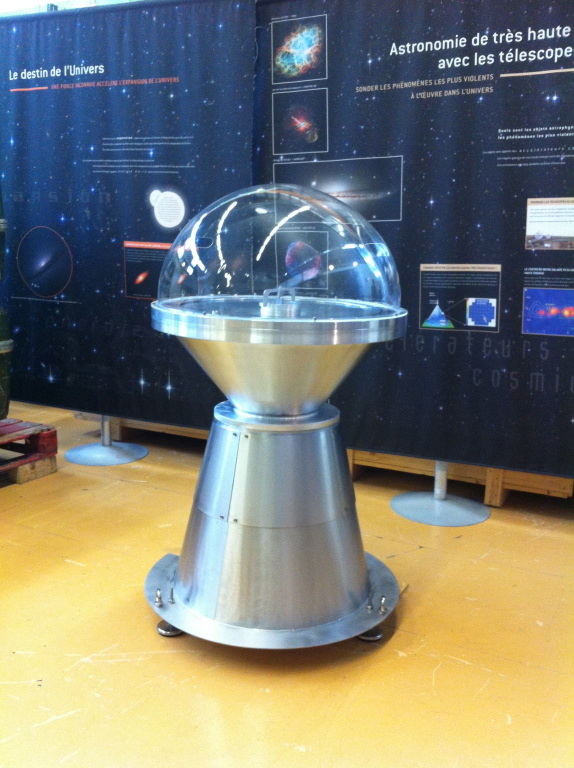
The explosive death of a massive star starts with the collapse of its core, when the mass of iron synthetized from the fusion of lighter nuclei approaches a critical threshold of 1.4 Msun, i.e. 40% more massive than our Sun.
In less than half a second, the iron core collapses from a radius of about 1500 km to a few tens of kilometers. It reaches a new equilibrium where gravity is balanced by the strong interaction between neutrons. A heavy rain of free falling iron nuclei reaching one tenth of the speed of light is abruptly decelerated across a spherical shock wave, 150 km away from the center.
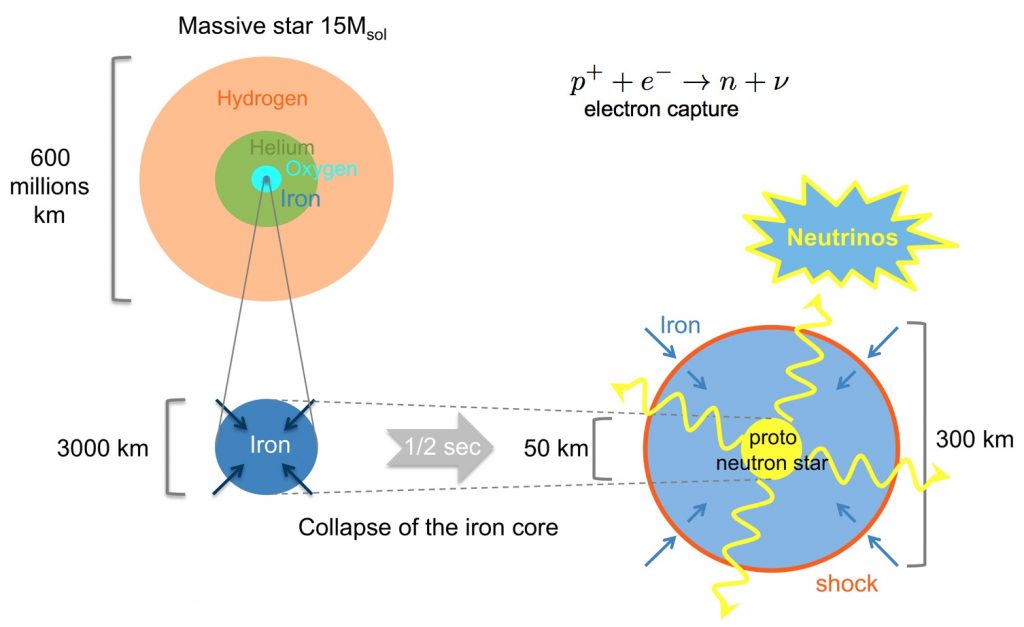
The main challenge of supernova theory is to understand the mechanism which transforms the collapse into an explosion. A direct bounce is excluded because of two major energy leaks. A significant fraction of the energy of the infall is lost in the dissociation of iron nuclei into protons and neutrons across the shock. Another major loss of energy occurs near the proto-neutron star after the transformation of protons and electrons into neutrons and very fast particles called « neutrinos ». Even more neutrinos are produced inside the proto-neutron star. Their relativistic velocities allow most of them to escape easily from the deep gravitational well as soon as they diffuse out of the densest regions.
A key ingredient for the onset of the explosion is thus the absorption of neutrinos in the dense region below the stalled shock while the shock is stalled at 150 km. The later the launching of the shock, the heavier the resulting neutron star due to the accumulation of infalling matter. The shock revival has to take place during the first second after the collapse to account for the typical mass of neutron stars in the range 1-2 Msun according to observations.
The shock may thus stall during a few hundred milliseconds before propagating outwards across the stellar envelope. This envelope is so large that it takes several hours for the shock to reach the stellar surface and produce the visible explosion called « supernova ».
Black hole formation may correspond to failed explosions since neutron stars heavier than a critical mass in the range 2-3 Msun are expected to collapse into a black hole, which may engulf most of the dying star.
Numerical simulations have revealed that hydrodynamical instabilities are able to change the shape of the postshock region by moving it sideways and favouring a direction for the absorption of neutrinos and for the launching of the shock wave.
Escaping neutrinos and gravitational waves carry a direct signature of the supernova mechanism. Two dozen neutrinos from a supernova were observed on earth for the first time in 1987 from SN1987A in the Large Magellanic Cloud neighbouring our Galaxy. Current detectors of neutrinos and gravitational waves are ready to observe the next galactic supernova.
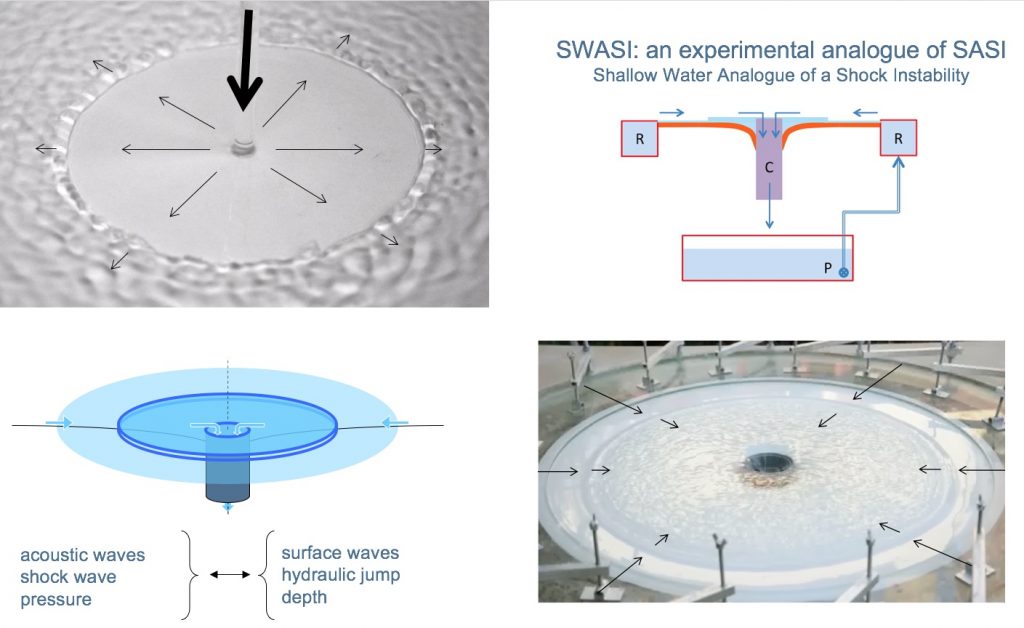
In the water experiment, the shock wave is mimicked by a hydraulic jump which is a sudden increase of water depth. This jump is similar to the circular hydraulic jump observed as water pouring from the tap encounters the flat bottom of the kitchen sink and flows radially outwards. The main difference in the experiment is that the fast fluid is radially injected inwards.
Water flowing from the outer rim of the experiment mimicks the gas of iron nuclei falling towards the proto-neutron star. Although the chemical composition of water is unchanged along the flow lines, some energy is also lost across the hydraulic jump due to viscous effects.
The vertical surface of the cylinder in the middle of the experiment mimicks the hard surface of the proto-neutron star. Instead of settling onto the surface of the proto-neutron star like neutronized matter would do, the water in the experiment is simply removed by spilling over the upper edge of the central cylinder.
The universal laws of fluid mechanics are responsible for the same dynamical behaviour in the fountain and in the idealized stellar core, at a scale one million times smaller. Using scaling laws, timescales in the experiment are expected to be hundred times slower than in the stellar core. The dynamical motions in the star are not only on a much larger scale, but also much faster than in the experiment.
Beside these analogies, the interesting phenomenon taking place in the experiment is the unstable evolution of the flow. Even though the inflow of water is stationary and uniform, some sideways motions appear with larger and larger amplitude. They transform the circular hydraulic jump into an oscillatory pattern which starts rotating while the inner region of the flow may surprisingly rotate in the opposite direction.
Illustrative videos:
Comparison of the experiment / shallow water simulation / stellar gas simulation
This sequence compares the water dynamics in the fountain (left) to the gas dynamics in the star (right). The central movie is a 2D simulation of the water dynamics relying on the shallow water approximation. In these three dynamical evolutions, the circular hydraulic jump or shock is destabilized into an oscillatory pattern in a random direction. As the amplitude of the oscillations grows, the pattern starts rotating in a direction which is also random.
The astrophysical flow viewd as a shallow water analogy
The similarities and differences between gas dynamics and the water experiment can be visualized by representing the analogue of the free surface of water associated with the astrophysical simulation, and comparing it to the experiment (high resolution version available here). The astrophysical fluid contains smaller scales that are smoothed out by surface tension in the experiment, and additional buoyancy effects.
The birth of a spinning neutron star from a non rotating collapsing stellar core.
A horizontal bar touching the water is used to visualize the transverse motions in the vicinity of the proto-neutron star. It is light enough to follow the fluid motions in a passive manner. As the hydraulic jump starts rotating, the inner region of the flow rotates in the opposite direction. This suggests that a star which does not rotate may give birth to a spinning neutron star. Calculations by Kazeroni, Guilet & Foglizzo (publication 2016) estimated that the neutron star could spin more than 10 times per second due to this process (details available here).
The saturation amplitude of spiral oscillations.
After a phase of growth, the amplitude of the transverse motions saturates with a spiral pattern rotating in a quasi-stationary manner, with a period of about 3 seconds (30 milliseconds in the stellar core). The mechanism responsible for this saturation may be due to the growth of parasitic instabilities associated with shear and vortices (publication by Guilet, Sato & Foglizzo 2010).
A counter-rotating neutron star.
If the core of the dying star is rotating during its collapse, it is likely to communicate its spin to the proto-neutron star and result in the same spin direction. However, the inner motions accompanying the development of the SASI instability may be strong enough to overcome the spin of the progenitor, as observed in the numerical simulations of Blondin & Mezzacappa (publication 2007). This example is the first experimental demonstration that a rotating massive star may thus give birth to a counter rotating neutron star.
Instability induced by the rotation of the stellar core.
If the rotation of the stellar core is fast enough, another instability due to differential rotation can contribute to redistribute angular momentum (publication by Kazeroni, Guilet & Foglizzo 2017). The spiral pattern seen in this video starts at a « corotation » radius where the angular velocity of the fluid matches the angular velocity of the pattern. This instability may be a source of gravitational waves.
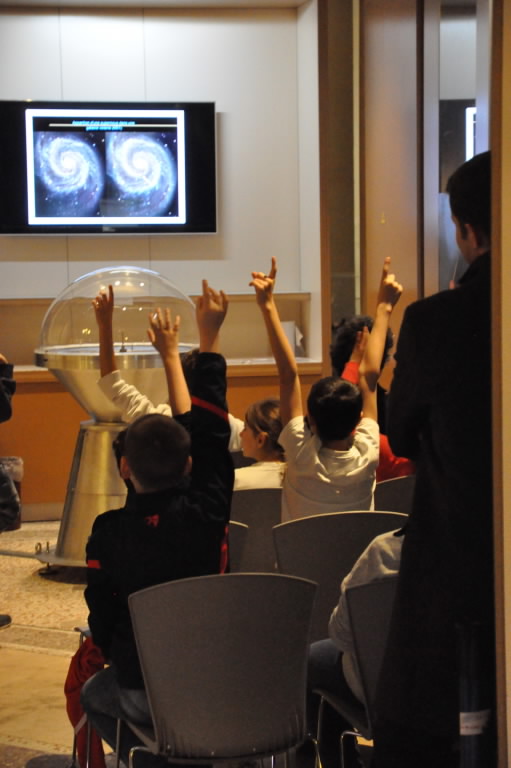
Why do spherical stars explode highly asymmetrically? The supernova fountain teaches us that spherical collapse can lead to transverse motions. In a similar manner, observing flapping flags teaches us that transverse motion do appear even in a regular homogeneous wind. Yes, we should expect sideways stellar explosions.
Why do neutron stars speed through interstellar space ten times faster than their massive parent stars? A sideways explosion results in a kicked neutron star due to a recoil effect. Global conservation of linear momentum is a fundamental law of mechanics.
What is the origin of the rapid rotation of many neutron stars? The supernova fountain teaches us that rotating motions develop even when the injected fluid is radial. While the hydraulic jump rotates in one direction, the inner regions of the flow rotate in the opposite direction. If the explosion proceeds and ejects the matter rotating with the unstable shock wave, the neutron star will be expected to rotate in the opposite direction. Global conservation of angular momentum is also a fundamental law of mechanics.
Neutron stars can even counter-rotate with respect to their parent stars! The supernova fountain teaches us that if the inflowing water rotates slowly enough, the spiral hydraulic jump is always prograde and the inner regions of the flow rotate in the retrograde direction. Yes, counter-rotating neutron stars could exist.
How can a simple water fountain experiment provide insight into such astrophysical questions? Even though the water dynamics in the fountain are much simpler than the 3D dynamics of a stellar core, advanced numerical simulations in 3D such as performed at MPA (link) suggest that this simple fountain captures several key processes of supernova theory.
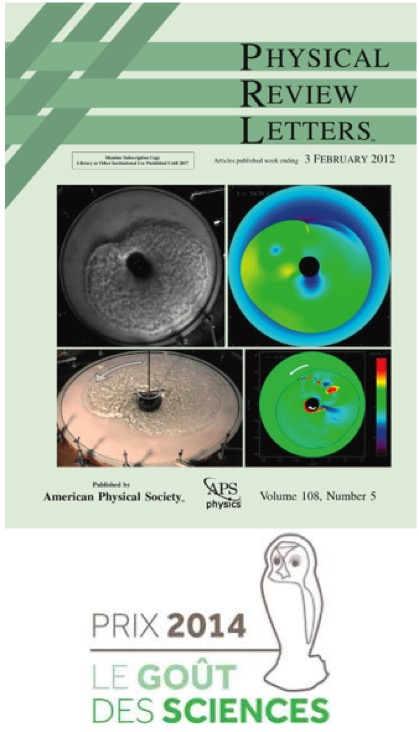
Further reading and internet links:
-A series of 5 lectures on supernovae by T. Foglizzo recorded at IAP Paris, January 2017 with videos and slides.
-Conference « Aspherical Stellar Explosions Illustrated by the Dynamics of a Water Fountain » for Physics Teachers at KITP Santa Barbara by T. Foglizzo, March 2017 with video and slides
-Handbook of supernovae, Chapter « Explosion Physics of Core-Collapse Supernovae » by Foglizzo 2017, Editors: Alsabti & Murdin, 1-22
–PASA review: « The Explosion Mechanism of Core-Collapse Supernovae: Progress in Supernova Theory and Experiments » by Foglizzo, Kazeroni, Guilet, Masset, González, Krueger, Novak, Oertel, Margueron, Faure, Martin, Blottiau, Peres, Durand 2015, Publications of the Astronomical Society of Australia 32, 17
–PRL publication: « Shallow Water Analogue of the Standing Accretion Shock Instability: Experimental Demonstration and a Two-Dimensional Model » by Foglizzo, Masset, Guilet, Durand 2012, Physical Review Letters 108, 05110
-Advanced modelling of stellar core collapse led by Thomas Janka at the Max Planck Institute for Astrophysics, Garching, Germany: first link to the MPA team and second link to the comparison of 3D simulations to the supernova fountain, including movies.
Credits: the supernova fountain is a project led by Thierry Foglizzo with the collaboration of Gilles Durand, Matthias González, Remi Kazeroni, Martial Mancip, Jérôme Guilet, Frédéric Masset, IRFU/SIS, SDMS, the SN2NS collaboration. The first public demonstrations of the supernova fountain at the Palais de la Découverte have been performed by a dedicated group of 12 researchers from 17 December 2013 to 16 February 2014. During this period, 2059 visitors discovered the physics of supernovae in 138 presentations by Thierry Foglizzo, Julien Faure, Rémi Kazeroni, Noël Martin, Jérôme Novak, Micaela Oertel, Patrick Blottiau, Elias Khan, Jérôme Guilet, Bruno Peres, Michael Urban, Jérôme Margueron.


